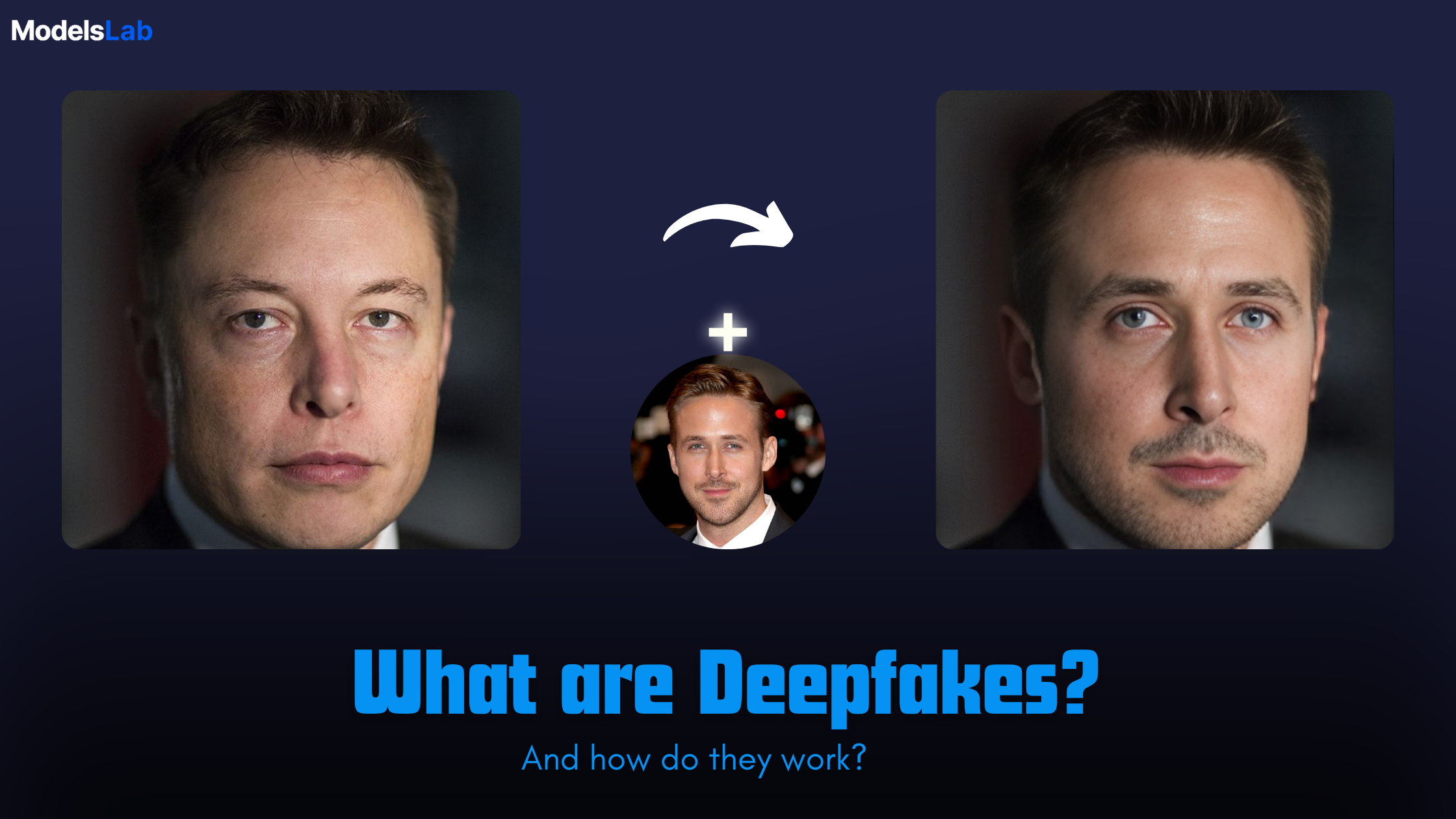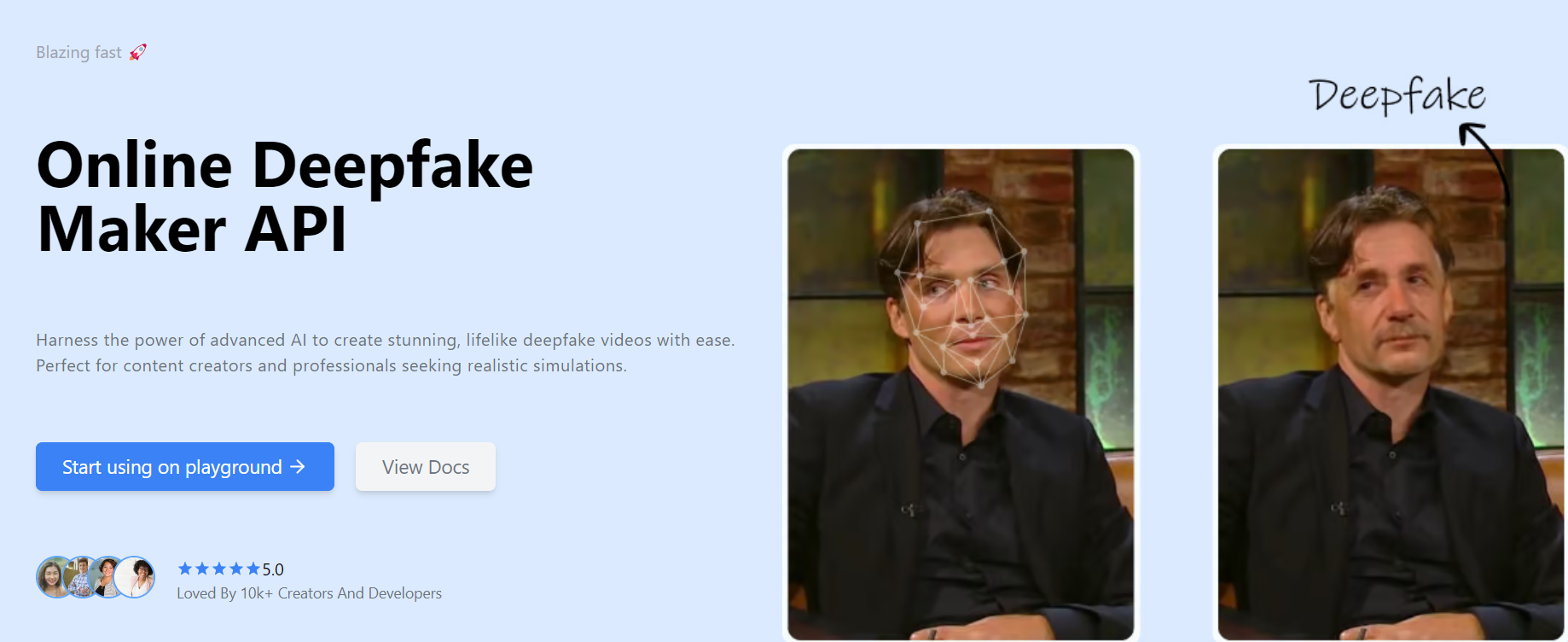What are Deepfakes and how does it work?
Written on . Posted in AI.
What are deepfakes and how do they work?
After 2019, there has been a surge in AI usage, with people using AI for productivity and business purposes. A similar trend is seen with deepfakes, as the number of deepfake users continues to grow, along with companies and startups like Modelslab in the field.
Many creators have gained millions of subscribers on social media, showcasing their creativity using deepfake technology, as well as text-to-image, text-to-video, text-to-music, and voice cloning tools.
However, many people are still unaware of this amazing technology. Whether you are a creator, a company, or someone who simply wants to learn more about deepfakes and the technology behind them, this blog is for you.
What is Deepfake?
Deepfake is a type of artificial intelligence technology used to create highly convincing but fake images, audio, and videos. The term "deepfake" is a combination of "deep learning" (a branch of machine learning) and "fake."
Deepfake technology primarily involves manipulating existing images, audio, or video to create realistic but false representations. Deepfakes often involve swapping faces in videos or making someone appear to say or do something they never actually did.
Additionally, deepfakes can generate completely original media that falsely represent people performing actions or making statements they never made. The end result is fake content that appears very real, which can be used to entertain audiences.
How does Deepfake work?
Deepfakes use two main algorithms, a generator, and a discriminator, to create and improve fake content. The generator starts by making the initial fake content based on the desired output, while the discriminator evaluates how real or fake that content looks. This process is repeated many times, with the generator improving its fakes and the discriminator getting better at spotting flaws, which the generator then fixes.
These two algorithms form a system called a generative adversarial network (GAN). GANs use deep learning to understand patterns in real images and then apply those patterns to create fake images. When taking a deepfake photo, a GAN looks at pictures of the person from different angles to capture all the details. For deepfake videos, the GAN also analyzes the person's movements and speech patterns. The discriminator checks and refines the content multiple times to make it as realistic as possible.
There are two main methods to create deepfake videos:
Source video deepfakes: Here, a neural network-based autoencoder studies a video of the person to learn their facial expressions and body language. It then applies these traits to another video, making it look like the person is doing or saying something they didn't actually do.
Face swaps: This involves replacing one person's face with another's in a video, making it appear as though the person in the video is someone else.
Other specific deepfake techniques include:
Audio deepfakes: A GAN copies a person's voice, creating a model of their vocal patterns to make the voice say anything the creator wants. This is often used in video games.
Lip syncing: This technique matches a voice recording to a video, making it seem like the person in the video is speaking the recorded words. If the audio is also a deepfake, it adds another layer of deception. This method is supported by recurrent neural networks.
In summary, deepfakes involve advanced AI techniques to create highly realistic but fake media, using various methods to manipulate images, audio, and video.
Technology requires the development of deepfakes
Developing deepfakes involves a combination of advanced technologies that make creating highly realistic fake media easier, more accurate, and more widespread. The key technologies required include:
GAN Neural Networks: Generative Adversarial Networks (GANs) are crucial for all deepfake content. They use two algorithms: a generator to create fake content and a discriminator to evaluate its realism, iteratively improving the results.
Convolutional Neural Networks (CNNs): These networks analyze patterns in visual data, making them essential for tasks like facial recognition and movement tracking in deepfakes.
Autoencoders: Autoencoders are neural networks that identify important features of a target, such as facial expressions and body movements, and then apply these features to the source video.
Natural Language Processing (NLP): NLP algorithms are used to create deepfake audio by analyzing a person's speech patterns and generating new audio that mimics their voice.
High-Performance Computing (HPC): HPC provides the substantial computing power needed to process and generate deepfake content quickly and efficiently.
Now let's move towards the use of deepfake.
How are deepfakes commonly used?
The use of deepfakes varies significantly. Here are some of the uses of deepfake:
Art and Creativity: Deepfakes can be used to generate new music, artworks, or creative content based on an artist's existing body of work. This can lead to innovative and unique artistic expressions.
Entertainment: Hollywood movies and video games often use deepfakes to clone and manipulate actors' voices and faces for certain scenes. This can be useful for difficult-to-shoot scenes, post-production work, or when an actor is unavailable. Deepfakes are also popular in satire and parody, creating humorous content that the audience knows is not real.
Caller Response Services: Deepfakes can provide personalized responses in automated caller services, making interactions more natural and efficient.
Customer Phone Support: Using synthesized voices, deepfake technology can be used for simple customer service tasks, such as checking account balances or filing complaints.
Historical Reconstructions: Deepfakes can recreate historical figures, allowing them to "speak" in documentaries or educational videos, providing a more engaging learning experience.
Create the best deepfakes with our advanced technology for growth and entertainment. Try it now!
How dangerous can be deepfakes?
Based on the purpose of creating deepfakes, they can be harmful in several circumstances, such as:
Blackmail and Reputation Harm: Deepfakes can be used to place individuals in compromising or illegal situations, such as lying, engaging in explicit acts, or taking drugs. These fake videos can be used for blackmail, revenge, or to ruin someone's reputation. Non Consensual deep fake porn, also known as revenge porn, is a common malicious use.
False Evidence: Fabricating false images or audio to create fake evidence that can imply guilt or innocence in legal cases, potentially leading to wrongful convictions or acquittals.
Fraud: Deepfakes can impersonate individuals to obtain personal information, such as bank accounts or credit card numbers. This can also include impersonating executives or employees to access sensitive company information, posing a significant cybersecurity threat.
Misinformation and Political Manipulation: Deepfake videos of politicians or public figures can sway public opinion and spread misinformation. For example, a deepfake of Ukrainian President Volodomyr Zelenskyy was used to create confusion during warfare.
Stock Manipulation: Fake videos or audio can be used to manipulate stock prices. For instance, a deepfake of a CEO making damaging statements about their company could lower its stock price, while a fake video of a technological breakthrough could raise it.
Blackmail and Reputation Harm: Deepfakes can be used to place individuals in compromising or illegal situations, such as lying, engaging in explicit acts, or taking drugs. These fake videos can be used for blackmail, revenge, or to ruin someone's reputation. Nonconsensual deepfake porn, also known as revenge porn, is a common malicious use.
Ethical consideration while using Deepfakes
Using deepfake technology irresponsibly can lead to significant misuse and harm, raising important legal and social concerns. Here are some key points and tips for using deepfakes responsibly to prevent negative impacts on society.
Misuse and Potential Harm
Deepfake technology, while innovative, can be misused in ways that harm individuals and society. As deepfakes become more realistic and easier to create, they can be used for fake news and disinformation campaigns that manipulate public opinion. Additionally, deepfakes can be used for blackmail or extortion by creating fake, yet convincing, content to damage someone's reputation.
Both marketers and consumers need to stay alert when viewing media online, as even with tools designed to detect deepfakes, it's still challenging to identify them accurately. Responsible use of deepfake technology is essential to prevent misuse.
In summary, deepfake AI technology offers exciting opportunities for creativity and innovation in fields like entertainment and marketing. However, its potential for harmful uses requires careful regulation to protect against these threats while enjoying its benefits.
Legal and Social Implications
Deepfake technology also presents significant legal and social challenges. Malicious use of deepfakes can have serious consequences for individuals, businesses, and society. Creating and using someone's image or voice without their consent is illegal in many places.
As deepfake algorithms improve with advancements in machine learning and artificial intelligence, detecting fake media becomes harder. This raises concerns about the legality and ethics of deepfakes.
Businesses should carefully consider how they use deepfake technology, balancing the potential benefits with the risks. Being mindful of these legal and social implications is crucial for using this powerful technology responsibly.
Tips for Responsible Use of Deepfake Technology
Marketing professionals can harness the power of deepfake technology responsibly by following these tips:
Understand Ethical Considerations: Be aware of the potential harm or misuse of deepfakes and consider the ethical implications of their use.
Legitimate Purposes Only: Use deepfake technology for appropriate and legitimate purposes, such as marketing campaigns, public service announcements, or educational content.
Disclosure: Always disclose when a video has been manipulated with deepfake technology to maintain transparency with your audience.
Avoid Harm: Do not use deepfake technology to create fake news, spread misinformation, or damage someone’s reputation.
Transparency and Permissions: Be clear about how you obtained the source material or images used in creating the deepfake. Ensure you have the necessary permissions to use them.
Verify Authenticity: Always verify the authenticity of videos before sharing them online to avoid spreading misinformation unintentionally.
Stay Informed: Keep up with new developments in deepfake technology to better understand its impact and potential risks.
By following to these guidelines, marketing professionals can use deepfake technology ethically and responsibly, leveraging its benefits for campaigns and messaging strategies.
Remember, responsible use of emerging technologies is important for maintaining trust with your audience and avoiding negative consequences associated with misuse.
Conclusion
Deepfake technology has transformed creative fields like entertainment and marketing, offering unprecedented capabilities in digital content creation. However, its use requires careful consideration of ethical and legal implications.
Modelslab provides the necessary tools for using deepfake technology responsibly. From creating realistic videos and images to cloning voices and generating text-based media, Modelslab empowers creators to innovate while maintaining ethical standards.

Explore the benefits of deepfakes with Modelslab deepfake maker. Whether you're a content creator, marketer, or educator, Modelslab's intuitive AI solutions can improveyour projects ethically.
Start with our powerful tools today and show your unpredictable capabilities with Modelslab's deepfake API.
